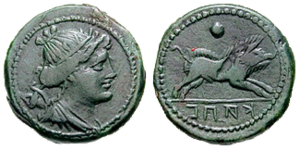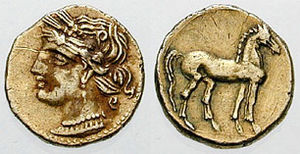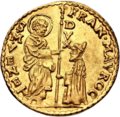| First period |
|---|
| Image | Value | Obverse | Reverse | Weight; diameter | Cataloging |
|---|
 | As | Collared heads of Juno and Jupiter turned to the right; Juno has a scepter on her left shoulder and bears a diadem on her head; Jupiter's head is laureate. | Jupiter standing on a quadriga galloping. In his left hand he holds a scepter and with his raised right hand throws a thunderbolt. In exergue KAPU. | 41-66 g; 38 mm (42,56 g) | HN Italy 481, Sambon 1022 |
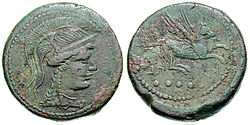 | Quincunx | Head of Minerva turned to the right. Wears Attic helmet with long crest. On the helmet in addition to the crest, plumes. | Pegasus flying to the right; below KAPU and value indication. | 26-34 g; 30 mm (26,16 g) | HN Italy 482, Sambon 1024 [28] |
 | Quadrunx | Laureate head of Jupiter, value below. | Winged lightning bolt; above KAPU and below value indication. | 23-27 g; 30 mm (24,48 g) | HN Italy 483, Sambon 1025 |
| Teruncius | Head of Ceres, with crown of ears of corn. | Bull; in exergue KAPU and above value indication. | 15-20 g; 25 mm | HN Italy 484, Sambon 1027 |
 | Biunx | Head of Fortuna, with turreted crown decorated with lightning; at left two stars, indicating value. | Horseman with lance, on horse forcené; murex shell underneath, two stars behind, indicating value; in exergue KAPU. | 13-17 g; 25 mm | HN Italy 485, Sambon 1028 [29] |
| Biunx | Laureate head of Jupiter, facing right. On left, behind head, two stars, indicating value. | Eagle turned right on lightning bolt, head turned back and wings spread. On both sides two eight-rayed stars, indicating value and in exergue KAPU. | 11-16 g; 23 mm | HN Italy 486, Sambon 1029 |
| Biunx | Laureate head of Jupiter, facing right. On left, behind head, two stars, indicating value. | Two soldiers, facing each other, the right hand of both armed with gladius, swearing an oath over a young swine which they both hold in their left hands; in the field, on the left the indication of value by means of two stars and in the exergue KAPU. | 13-16 g; 25 mm | HN Italy 487, Sambon 1030 |
 | Biunx | Laureate head of Jupiter, facing right. On left, behind head, two stars, indicating value. | Diana Tifatina [30] leading a swift biga, [25] running to the right; at top two stars, indicating value, in exergue KAPU. | 10,5-17 g; 23 mm | HN Italy 488, Sambon 1032 |
 | Biunx | Youthful haloed head of Hercules facing right; a club on his left shoulder. | Passing lion, snout in front, a spear in its mouth, held in place by its left paw; at top value indication and in exergue KAPU. | 10-15 g; 23 mm (14,0 g) | HN Italy 489, Sambon 1031 |
| Uncia | Head of Fortune facing right; girded with a turreted crown decorated with lightning; under the neck a star indicating value, a strigil behind. | Knight in cuirass and chlamys facing right with lance in rest on horse; on left a star indicating value and on right a shell, in exergue KAPU. | 7-10 g; 21 mm | HN Italy 490, Sambon 1035 [29] |
| Uncia | Head of Minerva turned to the right, wearing a Corinthian helmet with double welt; behind, as an indication of value, a star. | Victoria going left, nude bust holding in extended right arm a crown and in left hand a bandage; in front, as an indication of value, a star, in exergue KAPU. | 6-9 g; 20 mm | HN Italy 491, Sambon 1033 |
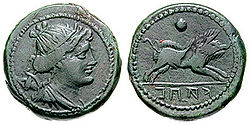 | Uncia | Head of Diana facing right, with myrtle wreath, bow, and quiver; value indication behind: a roundel or star. | Running boar to right, value indication above: a roundel; in exergue KAPU. | 6-10 g; 20 mm (7,09 g) | HN Italy 492, Sambon 1034 |
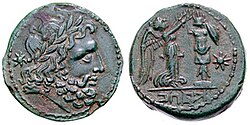 | Uncia | Laureate head of Jupiter turned right, behind a star, indication of value. | Victoria standing facing right crowning a trophy of arms; at right star and in exergue KAPU. | 6-12 g; 20 mm (7,20 g) | HN Italy 493, Sambon 1037 [31] |
| Uncia | Laureate head of Jupiter, facing right. On the left, behind the head, a star, indication of value. | Diana Tifatina [30] leading a swift biga, [25] running to the right; at top a star, indication of value, in exergue KAPU. | 7,4 g; 21 mm | HN Italy 494, Sambon — |
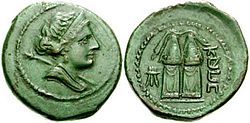 | Semuncia | Head of Juno turned right, scepter on shoulder, haloed and adorned with jewels. | Two xoana, gathered on a common base, veiled; a bandage is laid over the two heads. On the left is a symbol (triple knot); on the right, vertically, KAPU. | 4,5-7,5 g; 18 mm (6,48 g) | HN Italy 495, Sambon 1038 |
| Second period |
|---|
| As | Juvenile Janiform head, without beard | Jupiter standing on a quadriga galloping. In his left hand he holds a scepter and with his raised right hand throws a thunderbolt. In exergue KAPU. | 35,1-46,6 g; 36 mm | HN Italy 496, Sambon 1023 |
| Quincunx | Head of Minerva turned to the right. Wears Attic helmet with long crest. On the helmet in addition to the crest, plumes. | Pegasus flying to the right; KAPU and value indication below. | 17-22 g; 30 mm | HN Italy 497, Sambon 1024 [28] |
| Æ Biunx | Helmeted head of Minerva facing right. | Eagle turned left on lightning bolt; at left KAPU. | 3,7 g; 15 mm | HN Italy 498, Sambon – |
 | Æ semuncia (?) | Laureate head of Apollo, facing right. | Lyre with belt; on left KAPU. | 3-5 g; 16 mm (4,71 g) | HN Italy 499, Sambon 1041 |
 | Æ semuncia (?) | Veiled and haloed head of Juno facing right, holding a scepter on her shoulder. | Ear of wheat with two leaves; in the field on the left KAPU and on the right "triple knot" | 3-5,5 g; 16 mm (3,27 g) | HN Italy 500, Sambon 1040 |
| Æ semuncia (?) | Beardless head of Hercules turned right, a club behind his neck. | Doe turned right nursing young Telephus and turning head toward child. In right field "triple knot" and in exergue KAPU. | 4,5 g; 14 mm | HN Italy 501, Sambon 1045 |
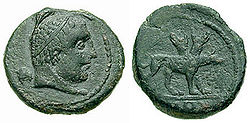 | Æ semuncia (?) | Head of beardless and haloed Hercules, facing right; a club behind his neck. | Cerberus facing right. In exergue KAPU. | 3,5-4,5 g; 15 mm (3,10 g) | HN Italy 502, Sambon 1044 |
| Third period |
|---|
| As | Laureate head of Jupiter, facing right. | Eagle turned right on lightning bolt, with open wings; in exergue KAPU. | 11-28 g; 34 mm | HN Italy 503, Sambon – [32] |
| Quincunx | Laureate head of Jupiter, facing right. | Eagle turned right on lightning bolt, with open wings; on the right, as an indication of value, a crescent, i.e. 1/2 (of as); in exergue KAPU. | 12-14 g; 25 mm | HN Italy 504, Sambon – |
| Uncia | Laureate head of Jupiter turned right, star behind, indication of value. | Victoria standing facing right crowning a trophy of arms; on right a star and in exergue KAPU. | 3,5 g; 20 mm | HN Italy 505, Sambon 1037 [31] |
| Uncia | Youthful head of Pan turned right, pedum on shoulder. | Wild boar running to the right. At top roundel, value indication. Demonym is missing. | 2 g; 15 mm | HN Italy 506, Sambon 1043 |
| Æ (semuncia?) | Head of Juno turned right, scepter on shoulder, haloed and adorned with jewels. [33] | Winged lightning bolt; at top triple knot and at bottom KAPU | 1,5-2 g; 13 mm | HN Italy 507, Sambon 1048 |
| Æ (semuncia?) | Head of Telephus facing right, wearing Phrygian cap | Doe toward right turning head back and suckling young Telephus; in exergue KAPU, at times, in field, triple knot. | 1-2,5 g; 13 mm | HN Italy 508, Sambon 1046 |
 | Æ (semuncia?) | Head of Telephus facing right, wearing Phrygian cap | Trophy; in exergue KAPU. | 1-2 g; 13 mm (1,82 g) | HN Italy 509, Sambon 1049 |
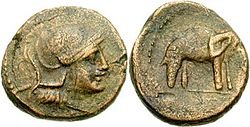 | Æ (semuncia?) | Head of Minerva facing right, with Attic helmet | Elephant facing right; in exergue KAPU | 1-3 g (2,24 g) | HN Italy 510, Sambon 1047 |
| N.B.: measurements are according to Rutter et al., HN Italy, pp. 64–66. In parentheses the weight of the specimen shown. |
